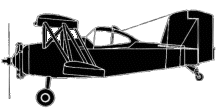
ASN Wikibase Occurrence # 245307
This information is added by users of ASN. Neither ASN nor the Flight Safety Foundation are responsible for the completeness or correctness of this information.
If you feel this information is incomplete or incorrect, you can submit corrected information.
| Date: | Tuesday 1 December 2020 |
| Time: | 14:30 LT |
| Type: |  Grumman G-164A AgCat |
| Owner/operator: | Riceland Aviation Inc |
| Registration: | N48594 |
| MSN: | 1677 |
| Year of manufacture: | 1976 |
| Total airframe hrs: | 7650 hours |
| Engine model: | Pratt & Whitney R1340-AN1 |
| Fatalities: | Fatalities: 0 / Occupants: 1 |
| Aircraft damage: | Substantial |
| Category: | Accident |
| Location: | southeast of Elton, Jeff Davis Parish, LA -
 United States of America United States of America
|
| Phase: | Manoeuvring (airshow, firefighting, ag.ops.) |
| Nature: | Agricultural |
| Departure airport: | Elton, LA |
| Elton, LA | |
| Investigating agency: | NTSB |
| Confidence Rating: |
According to the pilot, the airplane departed from a local grass strip at near maximum gross weight to fertilize a nearby ryegrass field. Shortly after takeoff, the engine began 'running bad," and the pilot added power, but the engine began running worse. The pilot reported the engine then stopped developing power and he made a forced landing in a muddy field about 1/4 mile from the grass strip. The airplane nosed over during the landing and came to rest inverted, sustaining substantial damage to the vertical stabilizer and rudder.
A postaccident examination of the airplane, which included the fuel system and a functional test of the magnetos, revealed no evidence of any preimpact mechanical malfunctions or failures that would have precluded normal operation.
The atmospheric conditions at the time of the accident were conducive to the accumulation of carburetor ice while operating at cruise or glide power setting. However, the engine power setting used during the takeoff would have been significantly higher than the cruise or descent engine setting; therefore, it is unlikely that carburetor ice accumulated during the accident takeoff. The reason for the loss of engine power could not be determined based on the available evidence.
Probable Cause: The loss of engine power, which resulted in a forced landing on unsuitable terrain. The reason for the loss of engine power could not be determined based on available evidence.
Accident investigation:
 |
|
Sources:
NTSB CEN21LA072
Location
Revision history:
| Date/time | Contributor | Updates |
|---|---|---|
| 02-Dec-2020 01:07 | Geno | Added |
| 02-Dec-2020 02:18 | Geno | Updated [Time, Source, Damage, Narrative] |
| 02-Dec-2020 05:41 | RobertMB | Updated [Aircraft type, Location, Narrative] |
| 03-Dec-2020 06:52 | harro | Updated [Aircraft type] |
| 03-Dec-2020 12:57 | RobertMB | Updated [Time, Aircraft type, Registration, Cn, Operator, Source] |
| 22-Feb-2021 19:50 | rudy | Updated [[Time, Aircraft type, Registration, Cn, Operator, Source]] |
| 27-Feb-2021 17:56 | rudy | Updated [[[Time, Aircraft type, Registration, Cn, Operator, Source]]] |
| 09-Mar-2021 19:02 | harro | Updated [Source] |
| 07-Jul-2022 19:06 | ASN Update Bot | Updated [Time, Other fatalities, Departure airport, Destination airport, Source, Narrative, Category, Accident report] |
Corrections or additions? ... Edit this accident description
The Aviation Safety Network is an exclusive service provided by:


 ©2024 Flight Safety Foundation
©2024 Flight Safety Foundation